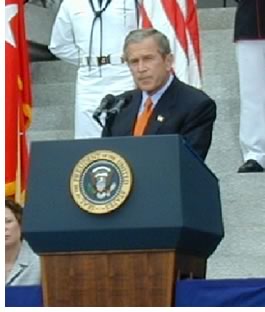

Associate Editor
President Bush and Congressional Democrats have offered separate plans in recent weeks to help stimulate the nation’s economy, both of which focus on tax relief for individual investors. While the proposals target personal income tax relief, a few provisions may spark particular interest for firms and architects looking for ways to manage their expenses.
 White
House officials say the president’s 10-year, $647 billion economic
package will pump up and reinforce the economy, creating more jobs and
opportunity for American investors and businesses. To stimulate investment
in business equipment and technology, it would raise the $25,000 cap on
write-offs for new equipment purchases to $75,000, a notable increase
targeted at small businesses. The administration’s plan also offers
tax credits for children and accelerates individual tax rate cuts, slated
to be phased in between 2004 and 2006, and makes them effective this year
and retroactive to January 1, 2003.
White
House officials say the president’s 10-year, $647 billion economic
package will pump up and reinforce the economy, creating more jobs and
opportunity for American investors and businesses. To stimulate investment
in business equipment and technology, it would raise the $25,000 cap on
write-offs for new equipment purchases to $75,000, a notable increase
targeted at small businesses. The administration’s plan also offers
tax credits for children and accelerates individual tax rate cuts, slated
to be phased in between 2004 and 2006, and makes them effective this year
and retroactive to January 1, 2003.
The Democrats have issued their own $136 billion stimulus package highlighting tax relief to individuals, investment incentives for small businesses, and billions of dollars for highway construction and one-time grants for homeland defense projects. The plan put forth by House minority Leader Nancy Pelosi (Calif.) would allow small businesses to double the amount they can deduct from income this year for the cost of new investments—from $25,000 to $50,000. To spur more spending on new physical plant and equipment this year, Democrats want to restructure the bonus depreciation schedule Congress put in place last year, permitting firms to write off a 50-percent bonus in 2003, which would drop to 10 percent in 2004, another boon for small business.
 State
budget woes continue
State
budget woes continue
State executives are among those who have expressed their disappointment
with the administration’s proposal to eliminate double taxation
of dividend income. They had hoped the president would infuse their coffers
with the cash they need to rebound from record deficits. Instead, they
fear Bush’s plan will add to their woes. According to the Center
on Budget and Policy Priorities, about 40 states link their incomes tax
statutes to the federal law, which means they will be unable to collect
tax revenue on corporate dividends. Even if, as some states have done,
they amend their tax statutes to untie themselves from the federal system,
they may have trouble collecting the money because the Internal Revenue
Service would no longer require taxpayers to fill out forms listing their
dividends, making it difficult to hold taxpayers accountable.
State and city officials also said they feared that eliminating dividend taxes would shift investments away from tax-free municipal bonds and toward stocks. State budget analysts say this would be particularly devastating for states, because these bonds help local and state governments finance costly transportation, school construction, and other infrastructure projects.
Vice President Dick Cheney, speaking at the U.S. Chamber of Commerce in Washington, D.C., this week countered their worries. Our “Council of Economic Advisors projects that the president’s job and growth package will increase our gross domestic product by four-tenths of a percent this year and 1.1 percent next year, boosting annual state revenues by some $6 billion. And these greater revenues will more than offset the revenue states lose from the dividend exclusion.” AIA leadership attended the vice president’s briefing.
New concerns about taxes, fees
The administration contends that its economic stimulus plan, particularly
the proposal to do away with the corporate dividend tax, will add about
$20 billion to the economy by reducing the tax burden on businesses and
individuals, which will in turn expand the tax base and lead to investment
in new jobs, equipment, and technology. State legislators and executives,
many of whom have already dipped into their rainy-day funds, worry that
the proposal will leave them to fight their own budget battles, which
may force them to reconsider taxes on professional services, additional
fees, or fee increases in other matters relevant to architecture practice.
Other areas for potential concern to architects include changes that states
may consider to processes governing design/build, the bidding of A/E services,
and construction management if officials believe these other alternatives
offer cost savings.
The AIA Government Affairs staff will continue to monitor federal and state proposals of interest to AIA member firms and architects. For more information, send an e-mail to govaffs@aia.org.
Copyright 2003 The American Institute of Architects. All rights reserved.
![]()